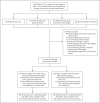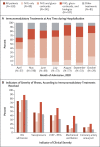Multisystem Inflammatory Syndrome in Children - Initial Therapy and Outcomes
- PMID: 34133855
- PMCID: PMC8220972
- DOI: 10.1056/NEJMoa2102605
Multisystem Inflammatory Syndrome in Children - Initial Therapy and Outcomes
Abstract
Background: The assessment of real-world effectiveness of immunomodulatory medications for multisystem inflammatory syndrome in children (MIS-C) may guide therapy.
Methods: We analyzed surveillance data on inpatients younger than 21 years of age who had MIS-C and were admitted to 1 of 58 U.S. hospitals between March 15 and October 31, 2020. The effectiveness of initial immunomodulatory therapy (day 0, indicating the first day any such therapy for MIS-C was given) with intravenous immune globulin (IVIG) plus glucocorticoids, as compared with IVIG alone, was evaluated with propensity-score matching and inverse probability weighting, with adjustment for baseline MIS-C severity and demographic characteristics. The primary outcome was cardiovascular dysfunction (a composite of left ventricular dysfunction or shock resulting in the use of vasopressors) on or after day 2. Secondary outcomes included the components of the primary outcome, the receipt of adjunctive treatment (glucocorticoids in patients not already receiving glucocorticoids on day 0, a biologic, or a second dose of IVIG) on or after day 1, and persistent or recurrent fever on or after day 2.
Results: A total of 518 patients with MIS-C (median age, 8.7 years) received at least one immunomodulatory therapy; 75% had been previously healthy, and 9 died. In the propensity-score-matched analysis, initial treatment with IVIG plus glucocorticoids (103 patients) was associated with a lower risk of cardiovascular dysfunction on or after day 2 than IVIG alone (103 patients) (17% vs. 31%; risk ratio, 0.56; 95% confidence interval [CI], 0.34 to 0.94). The risks of the components of the composite outcome were also lower among those who received IVIG plus glucocorticoids: left ventricular dysfunction occurred in 8% and 17% of the patients, respectively (risk ratio, 0.46; 95% CI, 0.19 to 1.15), and shock resulting in vasopressor use in 13% and 24% (risk ratio, 0.54; 95% CI, 0.29 to 1.00). The use of adjunctive therapy was lower among patients who received IVIG plus glucocorticoids than among those who received IVIG alone (34% vs. 70%; risk ratio, 0.49; 95% CI, 0.36 to 0.65), but the risk of fever was unaffected (31% and 40%, respectively; risk ratio, 0.78; 95% CI, 0.53 to 1.13). The inverse-probability-weighted analysis confirmed the results of the propensity-score-matched analysis.
Conclusions: Among children and adolescents with MIS-C, initial treatment with IVIG plus glucocorticoids was associated with a lower risk of new or persistent cardiovascular dysfunction than IVIG alone. (Funded by the Centers for Disease Control and Prevention.).
Copyright © 2021 Massachusetts Medical Society.
Figures



Comment in
-
Immunotherapy for MIS-C - IVIG, Glucocorticoids, and Biologics.N Engl J Med. 2021 Jul 1;385(1):74-75. doi: 10.1056/NEJMe2108276. Epub 2021 Jun 16. N Engl J Med. 2021. PMID: 34133878 Free PMC article. No abstract available.
-
Therapy for Multisystem Inflammatory Syndrome in Children.N Engl J Med. 2021 Sep 23;385(13):e42. doi: 10.1056/NEJMc2111096. Epub 2021 Aug 11. N Engl J Med. 2021. PMID: 34379918 No abstract available.
-
Therapy for Multisystem Inflammatory Syndrome in Children.N Engl J Med. 2021 Sep 23;385(13):e42. doi: 10.1056/NEJMc2111096. Epub 2021 Aug 11. N Engl J Med. 2021. PMID: 34379919 No abstract available.
References
-
- Valverde I, Singh Y, Sanchez-de-Toledo J, et al. Acute cardiovascular manifestations in 286 children with multisystem inflammatory syndrome associated with COVID-19 infection in Europe. Circulation 2021;143:21-32. - PubMed
Publication types
MeSH terms
Substances
Supplementary concepts
Grants and funding
LinkOut - more resources
Full Text Sources
Other Literature Sources
Medical
